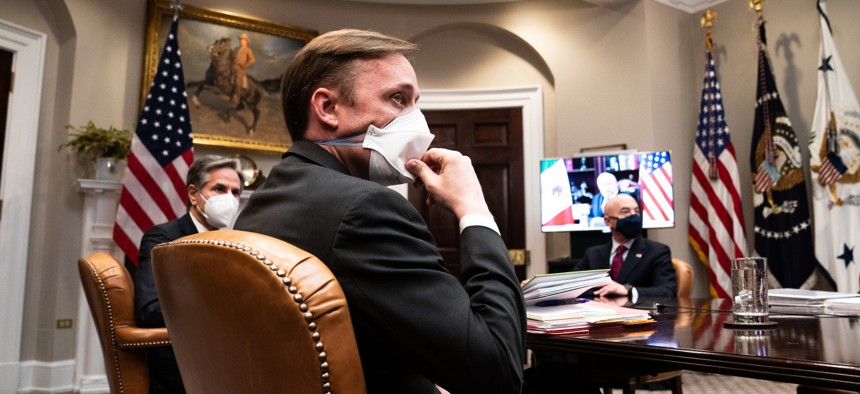
National Security Advisor Jake Sullivan listens during a virtual meeting with U.S. President Joe Biden and Mexican President Andrés Manuel López Obrador in the Roosevelt Room of the White House on March 1, 2021 in Washington, D.C. Anna Moneymaker-Pool/Getty Images
After Trump ‘Chaos,’ National Security Council Seeks a Return to ‘Regular Order’
The Biden White House is reinvigorating an interagency process some argue had largely halted under the Trump administration.
The Biden administration’s team of national security professionals is trying to make policymaking normal again.
When President Joe Biden took office in January, he took control of a national security decision-making apparatus that had been through one of the more tumultuous periods of American history. The officials serving during President Donald Trump’s presidency worked through a commander-in-chief temporarily sidelined by COVID-19, his impeachment for attempted bribery of Ukraine, alienating and insulting NATO allies, coddling and wooing adversaries and dictators, stoking conspiracy theories and domestic violent extremism, all culminated by the siege at the Capitol just weeks before.
“What the team inherited was not a blank page, but literally a burned page,” said John Gans, who published a book about the National Security Council in 2019. “It was disused, it was dysfunctional, and it was completely totally disconnected from any of the traditions and processes and norms by which the National Security Council has functioned for 70-something years.”
Biden’s team is committed to returning national security-making to regular order, including giving agency heads regular access to the president, holding scheduled meetings, and in many ways recreating the panel’s place during the Obama administration, a senior administration official told Defense One.
“The biggest thing we did was we literally made it clear that we expected decisions to be made rigorously as part of the regular order process,” the official said. “We hoped to show the NSC and the interagency that the way to advance an opinion was via the regular order process.”
It’s a mantra being echoed even by Defense Secretary Lloyd Austin at the Pentagon, where last month he said the administration sought a renewed focus on collaborative “teamwork” from allies aboard to the interagency partners in Washington. “Teamwork means a new spirit within this building,” he said. “It's time to get back to professionalism and normal order and good process.”
Biden’s national security team is getting one of its first major tests this week on the president’s first international trip, which has included meetings with British Prime Minister Boris Johnson, Queen Elizabeth, and other world leaders at the G-7 and NATO summits. The week-long trip will culminate with the much anticipated bilateral meeting with Russian President Vladimir Putin.
The Biden national security workforce put its new process into action for the first time mid-crisis during the coup in Myanmar, in February. “Within hours,” officials across multiple agencies began taking action, including issuing a new sanctions package from the Treasury Department and changing the assistance given by the U.S. Agency for International Development, plus coordinating press statements that all had the same messaging, the senior administration official said.
“That was illustrative of the team rowing in the same direction,” the official said.
That snapshot represents a dramatic departure from Trump’s time in office, where the president sometimes announced major policy changes via tweet—including a U.S. military withdrawal from Syria—catching agencies by surprise and leaving officials to scramble on how to respond to the changes.
That’s not to say the Obama-era system to which the Biden team is reverting didn’t have problems. Obama’s National Security Council officials faced a number of complaints, including holding too many repetitive meetings, micromanaging the agencies, and ignoring chains of command. Former defense secretaries Robert Gates and Leon Panetta in 2014 accused the Obama administration NSC’s of going as far as directly contacting top generals about strategy and trying to set up direct communication lines with combatant commanders, who report directly to the defense secretary.
But those criticisms do not compare to the problems that plagued Trump’s national security apparatus, Gans said. In four years, Trump cycled through four national security advisors atop the panel, senior staff were involved in the scandal involving aid given to Ukraine, and the president ordered a dramatic reduction in the council’s workforce, which “crippled the role of the NSC,” wrote Kathryn Dunn Tenpas, nonresident senior fellow for governance studies at the Brookings Institution.
“What some people used to think was bad process was a few errant or repetitive phone calls and too many meetings,” Gans said. “That looks quaint in comparison to what we saw in the Trump administration in terms of a breakdown in effective policy.”
One former senior defense official who served during the Obama and Trump administrations said that while the Obama-era was marked by a “very collaborative process” that could frustrate generals for its micromanaging, the early Trump years were “total chaos.”.
The Obama process often “paralyzed” the national security workforce in an endless “decision loop,” the former official said, but “I’ll pick the micromanagement over the chaos. Particularly when that chaos...as we saw at the end, that chaos became dangerous.”
The National Security Council was established in 1947 after President Franklin D. Roosevelt wanted to ignore bureaucracy and keep others out of the loop on decisions to win World War II. Roosevelt was so fond of acting alone that, when he died in office, his successor President Henry Truman knew little about the nuclear weapons being developed that would ultimately win the war, Gans said. The council was established under Truman to avoid having all information with a single person.
The panel as it was originally created is unrecognizable to the panel that exists today. The first iteration of the group had no staff and no national security advisor, said John Prados, author of a book on the history of the National Security Council called Keepers of the Keys. The original NSC included only the president, vice president, and secretaries of state and defense, plus the chairman of the Joint Chiefs of Staff and the CIA director in advisory roles. In the next administration, President Dwight D. Eisenhower established the role of special assistant for national security affairs, which later became the national security advisor under President Richard Nixon, and hired a staff, though staffers did not specialize in specific issue areas until the Kennedy administration. Under President John F. Kennedy, the staff grew to around one dozen people—small enough that there was a single rubber stamp pressed onto papers that had space for each staff member to check or initial that they had seen the document, Prados said.
The National Security Council has had its share of scandal—three top advisors have been convicted of crimes while serving in the role. But nobody’s NSC had “the amount of disorder and dysfunction” in such a short time period as Trump’s, Gans said. One of those disgraced top advisors is retired Army Lt. Gen. Michael Flynn, who was Trump’s closest national security confidant during his 2016 presidential campaign and first national security advisor in the White House. Trump, in his first year in office, also briefly added his 2016 campaign CEO Steve Bannon to the council’s Principals Committee. A U.S. judge last month dismissed federal charges that Bannon fraudulently pocketed funds meant for a U.S-Mexico border wall fund only because Trump already had pardoned him. Other Trump aides on the NSC were questioned as part of Trump’s first impeachment trial.
It’s unfair to lump all of Trump’s national security advisors together in the chaos, according to one former senior Trump administration official. While Flynn flamed out and John Bolton, Trump’s third national security advisor, did ignore the normal process and stopped holding meetings, others who served in the post, including then-Lt. Gen. H. R. McMaster and private lawyer Robert O’Brien, “ran it as a process” and followed more historically normal operations, the official said. All were outsiders to Trump’s inner circle before accepting the position.
Conversely, Biden’s team has a long history together. Many, including Secretary of State Antony Blinken, Director of National Intelligence Avril Haines, and Homeland Security Secretary Alejandro Mayorkas, served together in the Obama administration and have known each other for decades, as have many of their deputies and senior staff.
Because of those deep ties, “you have the space to energetically and rigorously debate a topic, and can assume good faith on all sides of the table,” the senior administration official said.
Today’s team is well aware of the micromanagement criticism from the Obama era and is trying to “learn from prior experiences,” the official said, by making sure agency heads can regularly talk to each other and have open lines of communication with the president.
Still, some outsiders worry the Biden NSC is a return to bloated bureaucracy, with duplication in certain areas. The former senior Trump administration official pointed to multiple people working on China policy at the NSC, which along with China experts elsewhere in the White House and the agencies means that a larger group must meet to make any major policy decisions.
“The coordination at the NSC itself I think is more complicated today because there are more people and more overlap in their mission sets. That’s separate from interagency coordination,” the official said. “So inevitably you’re going to have more bureaucracy.”
Those who study National Security Council history generally said Biden’s national security advisor, Jake Sullivan, seems to be running the panel well. One thing they’re getting right is letting the president and secretaries play public roles, while the work of Sullivan and his staff remains largely behind closed doors, said I.M. ‘Mac’ Destler, who co-authored In the Shadow of the Oval Office, a book on the role of the national security advisor. One indicator of that success: the few news stories, so far, about this National Security Council.
“There hasn’t been a lot of coverage of it,” he said. “That means it’s probably working fairly smoothly. If it wasn’t, there’d be a lot of noise.”
It also could just be too early to tell because the coronavirus pandemic has delayed how quickly the Biden administration could bring on staff and get everyone in the same room.
“I think we’re just starting to see what the process will finally be like as more people are vaccinated and there’s more in-person stuff,” Gans said. “They have a pretty small crew due to COVID and delayed confirmations, so they can make decisions very quickly without the bureaucratic intrigue….We’ll see traditional bureaucratic politics and the intrigue that go with high-stakes decisions occur more as people open up, employees report to work, and the team gets bigger.”
Less than five months into Biden’s presidency, the NSC already has had to contend with a few security challenges and decisions already, including withdrawing U.S. troops from Afghanistan, reacting to the 11-day Israeli-Palestinan conflict, reestablishing U.S.-China talks, planning a summit with Russia’s Vladimir Putin, managing pandemic response, reentering the Paris climate accords, and crafting the administration's first budget request for Congress.
At the Pentagon, Joint Staff officials did not respond to a question about what it’s been like working through each of this issues within Biden’s new National Security Council processes, but a former defense official said it’s likely very similar to the organized but sometimes frustrating decision-making chain under Obama, because so many of today’s personnel also served in that administration.
“From what I’ve observed, it seems like Biden is getting the old band back together, and a lot of the same people are coming back,” the official said. “Given that...my suspicion is they’ve resurrected a lot of this process and procedural stuff that had worked before.”
